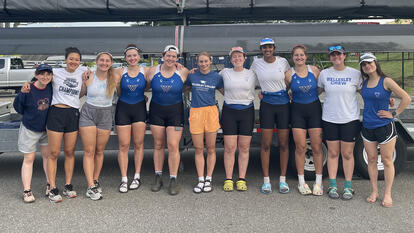M. Darby Dyar ’80 Wins Prestigious G.K. Gilbert Award from the Geological Society of America

On September 27, M. Darby Dyar ’80 became just the fourth woman—and the second Wellesley alumna—to receive the prestigious G.K. Gilbert Award for outstanding contributions to the solution of fundamental problems in planetary geology from the Geological Society of America. The award is named after G.K. Gilbert, who recognized, more than 100 years ago, the importance of physical, chemical, and biological processes operating at or near a planet’s surface.
“Gilbert’s curiosity and broad-ranging thinking continue to inspire people to this day, so it’s a tremendous honor that Darby Dyar is a link in this tradition,” said Margaret Thompson, professor emerita of geosciences at Wellesley, who taught Dyar as an undergraduate and helped nominate her for the award. “In addition to her ongoing work with the Mars Science Laboratory, which is charged with the mission of determining past habitability of that planet, Darby has devoted her whole teaching career to the liberal arts model.”
Dyar, professor and chair of the Department of Astronomy at Mount Holyoke College, said in her acceptance speech that Wellesley taught her women can do anything. Still, she has found that there are too few successful women scientists who mix caring for their families with teaching full time, mentoring students, and pursuing vigorous research programs.
“Those of us who focus on undergraduate education lay a strong foundation for many who succeed in our profession,” Dyar said. “I will happily accept this award on behalf of the thousands of us in the teaching ranks who use research not only as an end to itself, but as a vehicle to teach the next generation what it means to be a scientist.”
Dyar, whose research focuses on understanding how hydrogen and oxygen are distributed throughout the solar system, didn’t know what it means to be a scientist, she said, until she enrolled in Dynamic Earth, an introductory geology course, as a sophomore to fulfill a degree requirement.
“On the first day, I slouched in the back row, my body language making it clear that I did not feel I belonged there,” said Dyar, who had planned to major in art history. She had only taken one science class in high school—ninth-grade biology—and that did not go well. “Imagine my surprise when Meg Thompson walked in and started to show slides of gorgeous scenery and explain the geology behind them. I instantly grasped what she was saying and was drawn in,” said Dyar, who had never met a woman scientist before.
Once Dyar “saw the light,” as Thompson said, several faculty members rallied to help her complete the geology major. “Phyllis Fleming helped me understand physics, and Jim Besancon tutored me through all my chemistry classes, which I found completely incomprehensible,” Dyar said. Besancon, associate professor of geosciences, also helped Dyar find a work-study job with a professor at MIT during her senior year. Harold Andrews taught a computers in geosciences course at Wellesley that prepared her for the research she does now, analyzing spectroscopic data with machine learning.
Dyar worked with Thompson on her senior thesis, for which she identified rock formations along the Charles River in the Broadmoor Wildlife Sanctuary, run by the Massachusetts Audubon Society, in Natick, Mass. That experience would prove helpful when Dyar enrolled in the geochemistry doctoral program at MIT to study lunar samples, and when she developed instrumentation, roughly 20 years later, that enabled NASA’s Curiosity rover to collect data about the geological formations on the surface of Mars.
“I feel an obligation as a scientist to aspire to positions where I can be highly visible as a woman, just as Meg inspired me so many years ago,” said Dyar, whose students at Mount Holyoke have helped her analyze readings from Curiosity over the past four years and compare them with hundreds of mineral samples Dyar had previously collected on Earth.
For Dyar, who represents the third successive generation of Wellesley women in her family—her daughter, Lindy Crowley ’19, is the fourth—none of this would have been possible without the liberal arts education and unwavering support she received as an undergrad studying both art history and geology. “Thanks to Wellesley, I found two intellectual passions, and today I understand that they are not unrelated. The skill of visualization is as important in the study of science as it is in art,” she said.
“From studying art, I also learned how to write critically, articulate clearly, think quantitatively, and express highly spatial concepts in writing. All these skills serve me now as a scientist, where my interdisciplinary work requires confidence, the humility to recognize what I don’t know, and the willingness to reach across disciplines to make new discoveries,” she said.



